Come cambiare la posizione di backup di iTunes
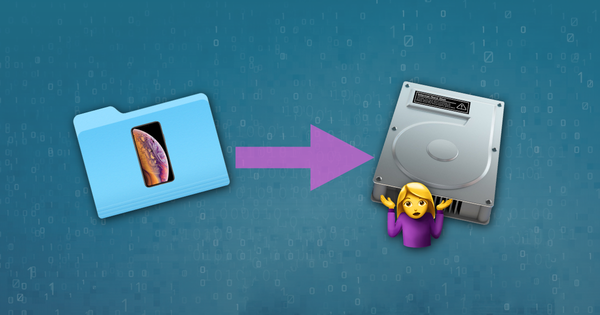
La posizione di backup predefinita di iTunes è impostata sul PC o sul disco primario del Mac e, in macOS 10.15, i backup di iOS creati da Finder vengono archiviati nella stessa posizione. Molti utenti dispongono di backup o backup di grandi dimensioni da un numero di dispositivi iOS e, di conseguenza, si trovano a corto di spazio su disco.
È possibile configurare un computer in modo che iTunes esegua il backup su un disco rigido secondario o su un HDD o NAS esterno.
In poche parole, questo viene fatto sostituendo la cartella di backup di iTunes con un collegamento simbolico alla posizione desiderata. Questa è una modifica facilmente reversibile, quindi è possibile ripristinare la posizione di backup predefinita nella sua directory originale.
Si noti che se la posizione di backup di iTunes viene modificata in un volume che non è disponibile in qualsiasi momento, il processo di backup di iTunes fallirà quando la nuova posizione non sarà disponibile.
Di cosa avrai bisogno
Per modificare la posizione di backup di iTunes predefinita del tuo computer, è necessario quanto segue:
- Competenza media con PC o Mac
- 10 minuti
- Una comprensione del nuovo percorso di posizione di backup desiderato
- Un Mac con macOS 10.7 o successivo o un PC con Windows Vista o versione successiva
- Il team di supporto di Reincubate è a disposizione per aiutare e può consigliare i clienti su come farlo.
Modifica automatica della cartella di backup di iTunes iOS
La versione gratuita di iPhone Backup Extractor ti mostrerà automaticamente la posizione di backup di iTunes predefinita del tuo computer e ti consentirà di cambiarla.
- Scarica e installa iPhone Backup Extractor .
- Scegli
Preferencesdal menu principale - Selezionare
BackupsdalPreferencesfinestra![Il riquadro "Preferenze" che mostra le posizioni di backup The "Preferences" pane showing backup locations]()
Il riquadro "Preferenze" che mostra le posizioni di backup - Fai clic sul pulsante
Changeper avviare il processo di modifica della cartella di backup predefinita di iTunes.
Modifica manuale della cartella di backup di iTunes iOS su Windows
- Open the default Backup location in Explorer using the Windows Run command. Press
⊞ Win+Rand the Run window should appear. For Windows 7, 8 and Windows 10 iTunes Apple version, enter%APPDATA%\Apple Computer\MobileSyncand press⏎ Enter. For iTunes Microsoft Store version, enter\Users\[USERNAME]\Apple\MobileSync\Backup, where[USERNAME]is your Windows user name. - La finestra Esplora che verrà visualizzata mostrerà una cartella denominata "Backup". Questo contiene tutti i backup di iTunes che sono già presenti sul computer. Per cambiare la posizione della cartella di backup, questa cartella deve essere rinominata, spostata o cancellata. Ad esempio, si potrebbe rinominarlo in "Backup (vecchio)".
- Una volta che la cartella "Backup" è stata rinominata, spostata o cancellata, è possibile creare un collegamento simbolico alla posizione di backup desiderata. Per fare ciò, è necessario aprire una finestra di comando. Tenendo premuto
⇧ Shifte facendo clic con il pulsante destro del mouse nella finestra diMobileSyncExplorer aperta di recente, gli utenti vedranno un menu con l'opzione "Apri finestra di comando qui" o "Apri la finestra di PowerShell qui". Clicca qui - Utilizzare il seguente comando
mklink /d Backup "[desired-new-backup-path]". Dopo aver inserito questo comando, premere⏎ Entere il cambiamento sarà completo. - Dopo aver riavviato Windows, iTunes memorizzerà i suoi backup nella nuova posizione.
Modifica manuale della cartella di backup di iTunes iOS su macOS
- Avvia l'applicazione macOS Terminal. Questo può essere trovato usando Finder, sotto
Applications / Utilities / Terminal. In alternativa, può essere lanciato utilizzando Spotlight premendo⌘ Cmd+e digitando "Terminale" prima di premere⏎ Enter. - Indicare al terminale di passare alla posizione di backup predefinita di iTunes, inserendo
cd ~/Library/Application\ Support/MobileSynce quindi premendo⏎ Enter. - Rivela la cartella di backup corrente nel Finder inserendo
open .e quindi premendo⏎ Enter. - La finestra del Finder che si apre mostrerà una cartella denominata "Backup". Questo contiene tutti i backup di iTunes che sono già presenti sul computer. Per cambiare la posizione della cartella di backup, questa cartella deve essere rinominata, spostata o cancellata. Ad esempio, si potrebbe rinominarlo in "Backup (vecchio)".
- Una volta che la cartella "Backup" è stata rinominata, spostata o cancellata, è possibile creare un collegamento simbolico alla posizione di backup desiderata. Utilizzare il seguente comando
ln -s [desired-new-backup-path] ~/Library/Application\ Support/MobileSync/Backup. Dopo aver inserito questo comando, premere⏎ Entere il cambiamento sarà completo. - Dopo aver riavviato il Mac, iTunes memorizzerà i suoi backup nella nuova posizione.
Come ripristinare la cartella di backup di iTunes nella posizione originale
Se hai seguito i passaggi precedenti e vorresti reverificare la modifica, il processo è semplice:
- Passare alla cartella di backup di iTunes .
- Elimina il
Backupsimbolico diBackupche verrà visualizzato lì. - Trascina nuovamente la cartella di
Backuporiginale, rinominandola se necessario in modo che corrisponda al nome originale.
Altre sfide?
Alcuni utenti hanno contattato chi ha già spostato la propria cartella di backup di iTunes in un'altra posizione, semplicemente trascinandola, e ora manca il collegamento simbolico necessario affinché iTunes possa vedere il backup.
È facile da risolvere e ci sono due opzioni:
Trascina nuovamente la cartella dove hai trovato in origine. Se hai dimenticato, dovrebbe essere chiamato
Backup, e risiede in~/Library/Application Support/MobileSync.Creare un collegamento simbolico che punta ad esso - nello stesso modo in cui le istruzioni sopra descritte. Se sei in questa fase, dovresti aprire un Terminale e fare questo:
cd [location of the folder which now has "Backup" in it] ln -s Backup ~/Library/Application\ Support/MobileSync
Dovrebbe essere così semplice.
Ci sono situazioni in cui questo non è possibile?
Questa tecnica funziona su ogni Mac, ma non funzionerà su PC Windows costruiti prima del 2000. Prima del rilascio di Windows 2000, Windows utilizzava i file system formattati in FAT per impostazione predefinita e quelli non sono in grado di creare collegamenti simbolici. Qualunque build su PC Windows da allora utilizzerà quasi certamente dischi in formato NTFS e questi supportano collegamenti simbolici. Se si esegue la FAT e si tenta di creare un collegamento, è possibile che Local volumes are required to complete the operation. visualizzato questo errore: Local volumes are required to complete the operation.
Fortunatamente, Microsoft fornisce alcune istruzioni su come aggiornare un disco da FAT a NTFS . È un po 'più tecnico, ma è possibile.
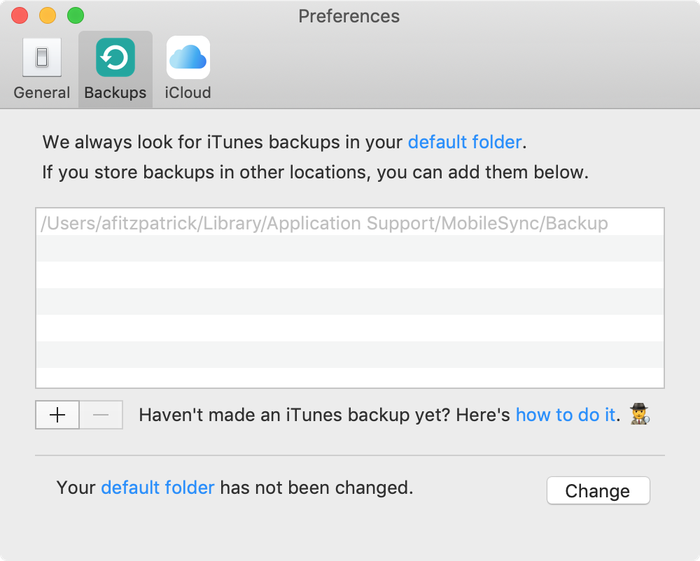

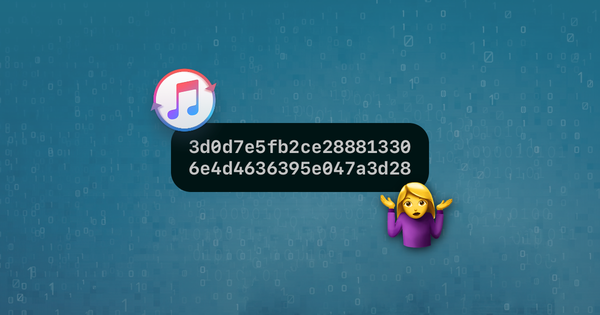

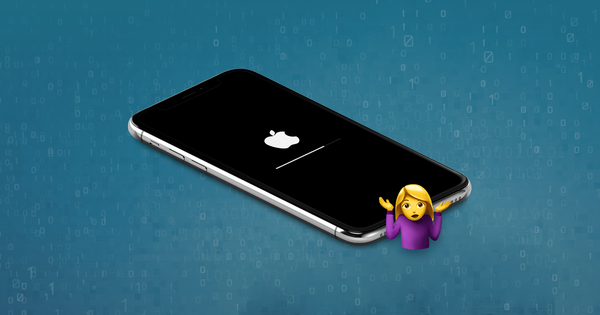
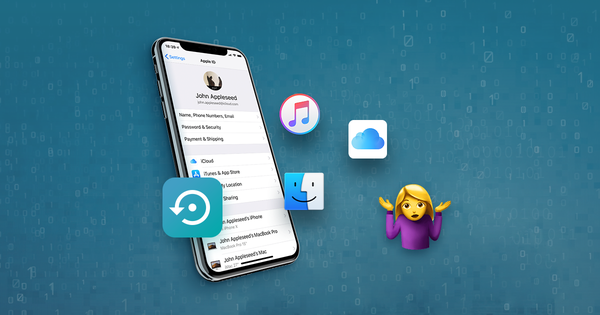

di Gael
Bonjour,
J'essaie tant bien que mal de déplacer ce Backup et de créer un lien symbolique. Cependant, la seule réponse que j'ai est: illegal option -- /
Je vous laisse le chemin que j'utilise et si une âme charitable veut bien m'aiguiller. Merci :)
ln -s/Volumes/VERBATIM\ HD/SAUVEGARDE\ IPHONE/ ~/Library/Application\ Support/MobileSync/Backup ln: illegal option -- / usage: ln [-Ffhinsv] source_file [target_file] ln [-Ffhinsv] source_file ... target_dir link source_file target_file
risposta di: Reincubate Support
Salut Gael, merci d'avoir écrit! Le problème ici est l'espace ("") entre votre chemin et les barres obliques.
Il doit s'agir de
ln -s /Volumes/VERBATIM\ HD/SAUVEGARDE\ IPHONE/ ~ /Library/Application\ Support/MobileSync/Backup, et non deln -s / Volumes / VERBATIM \ HD / SAUVEGARDE \ IPHONE / ~ / Library / Application \ Support / MobileSync / BackupFaites-nous savoir si vous avez besoin d'aide! 🙂
di Alex
Backing up to remote Synology server (not local). All you need:
thanks
di Samuel Kwok
Exactly what I needed. I don't want to store on my MacBook as it takes 200GB. This allows me to move to a Time Capsule. I don't use Time Machine but I use Time Capsule as a network drive and another copy of the whole Time Capsule to another network drive.
risposta di: Reincubate Support
Glad it helped!
di Rick Galloway
I've got the symbolic link created, but my iPhone back up still goes to the original C: drive location. When I look on my k: drive, I do not see the symbolic link file subdirectory even though it said it was created.
risposta di: Reincubate Support
Hi Rick: the symlink should be in your C: drive, in
MobileSync, and calledBackups. It'd be that that points to the K: drive in your case. If you get stuck, why not use the functionality in iPhone Backup Extractor? It can do it for you, and it's in the free edition.di Colleen Gordon
How do I figure out the my desired new backup location path? I want to use an external drive.
risposta di: Reincubate Support
Hi Colleen, thanks for commenting. If you use the functionality in iPhone Backup Extractor to change location, you can make the change simply by browsing to the folder you want. That might be easier! 🙂
di Mike L.
A fix to the insufficient permissions error--
Since I got the permissions insufficient in both cmd and powershell. First you search
cmdand then right click the command prompt app and run as admin. Navigate to the directory using the cd command ex.(cd c:\users\youruser\apple\mobilesync). once in the directory you can use the (mklink /d backup [new directory]) command listed in the article. That worked for me.As a side note, when using the cd command to navigate remember that you will likely have to put any folders with a space in the name inside quotation marks ex.(
cd c:\users\"this user"\apple\mobilesync). hopefully this helps some avoid the hassle of having to figure out this process if you get that persistent insufficient permissions response.di Aaron
Hello Aidan!
So I'm trying to change the backup path on Windows, and of course get the "insufficient privilege" error in the regular Powershell. So I ran it as administrator by typing it in the search bar and it said it created the symbolic link to the location, so I restarted my PC & tried updating iOs but the backup still went through to the original location (my hard drive, while I wanna change it to an external one simply 'cause I don't have enough space left on the former, lol).
So I guess my question is: how do I run Powershell in the MobileSync window as admin/how do I get the one I open through the search bar as admin to go to the MobileSync folder location so I can properly create the symbolic link & switch it up? :/
P.S. I did skip step one if I'm being honest, but only did so 'cause I already found the location manually, then proceeded to follow the instructions w/ renaming the folder, etc. Might this be the reason why it's not working? If so, shall I re-rename it to its original "Backup" name and try it again with the 1st step? I doubt it since I can't get the Powershell to go to the MobileSync location while I run it as admin to begin with/can't change it without running it as admin in the aforementioned window...Then again what do I know, lol.
P.P.S. Does the admin-run Powershell not need the MobileSync path to be put in and can successfully render the switcheroo by typing the featured command right after the "system32" path? If so, what seems to be the problem?
I was hoping to update my iOS tonight, and am getting more & more frustrated as we speak. Sorry for the post being so jumbled, hope all's clear. Thanks for the help!
risposta di: Reincubate Support
Hi Aaron, thanks for the comment.
Yes, if you skipped step 1 your Powershell will be looking in the wrong folder, so it won't have created the symbolic link in the right place.
If you've already got a Powershell or command window open, you can make it change folder with this command:
cd %APPDATA%\Apple Computer\MobileSync(If it's looking at the wrong drive, you'll have to change drive by typing
C:.)We've reached out to you directly to help, but if anyone else runs into the same problem, we'd recommend undoing the steps you took, starting over, and making sure to include the first step. 🙂
di Mohamed
I tried it, the following error popped up .. Plz advise
risposta di: Reincubate Support
Hi Mohamed, it looks like you're using PowerShell to run the command. If that's the case, you must prefix you command with
cmd /c, so it's likecmd /c mklink, etc.di Sean
I'm trying to do this on Mac OS 10.14.6 (Mohave), but when I try Step 5, I receive a "Operation Not Permitted" message. Any ideas...?
risposta di: Reincubate Support
Hi Sean, thanks for commenting. On macOS Mojave and newer, you'll need to grant "Full Disk Access" to your Terminal in order to make the change. There's a how-to on how to do this for iPhone Backup Extractor here, I hope that helps!
di Max
Thank you for the article. Here are a few notes to help somebody.
CD(include space). Example:CD C:\Users\Username (change this)\AppData\Roaming\Apple Computer\MobileSyncmklink /d Backup "L:\Users\XYZ"di Joe
I'm still having trouble with permissions, when I open up powershell in admin I get a command line PS
C:\Windows\System32>I don't seem to be able to open it in admin mode from the file path of the itunes back up.risposta di: Reincubate Support
Hey Joe, you can change directory using the
cdcommand. Try this:cd %APPDATA%\Apple Computer\MobileSyncdi Jess
Thanks for this assistance! I too got stuck on the "you do not have sufficient privilege to perform this operation." I then followed your advice in the comments above and ran Powershell as an administrator, but the Powershell window that opens from the MobileSync folder doesn't seem to recognize that and keeps giving me the same message. What do I do from here? Thanks!
risposta di: Reincubate Support
Hey Jess, thanks for writing. It's the same privilege error you're getting? If you drop us a note I'm sure we can guide you through it.
di Андрей
У меня выдает ошибку в PowerShell mklink : Имя "mklink" не распознано как имя командлета, функции, файла сценария или выполняемой программы. Проверьте правильность написания имени, а также наличие и правильность пути, после чего повторите попытку. строка:1 знак:1 + mklink /d Backup "[desired-new-backup-path]" + ~~~~~~ + CategoryInfo : ObjectNotFound: (mklink:String) [], CommandNotFoundException + FullyQualifiedErrorId : CommandNotFoundException
risposta di: Reincubate Support
Привет Андрей, попробуй
cmd /c mklinkи так далее 🙂di Hogan
Hi Aidan, Thanks for your amazing instructions!
I have run them on my Mac but got an error saying "Library/Application Support/MobileSync/Backup: No such file or directory". I guess this happened because I have renamed the old "Backup" file. Actually, it also confuses me a lot when u say "Once the 'Backup' folder has been renamed.../Backup", as the original "Backup" file doesn't exist anymore(right?)
Looking forward to your further clarification. Thanks :)
risposta di: Reincubate Support
Hi Hogan, thanks for your kind words. That second "Backup" reference is assuming you didn't change the folder's name, but simply moved it elsewhere. If you did rename it, you'd want to change it in that command. I hope this is clear. If it's not, do drop us a note. (Or use iPhone Backup Extractor to move it for you, as the free version can automate this process.)
di Luna
hi i get this message when i try and finalize the path: "You do not have sufficient privilege to perform this operation." It's my computer and i understand it has to do with admin rights but how do i run windows powershell as admin?
risposta di: Reincubate Support
Hey Luna! No problem: on Windows, you'd click on the "Start" button, then type "powershell". You'll see the menu search eventually shows you the PowerShell icon. If you right-click on that, you'll see there's a "Run as Administrator" option. Good luck -- I've asked our support team to drop you an email directly in case you need further help. 🙂
di Cedric koh
If I were to delete the backup symlink in the itunes MobileSync folder,how will that affect the backup folder i used for the symlink in my other drive? Will the files inside the backup folder in my other drive be unusable?
risposta di: Reincubate Support
Hi, thanks for stopping by. Removing the symlink is safe: it will effectively just remove the pointer to the backup folder on your other drive. The files will still be usable, but iTunes (or Finder) won't know where to look for them.
You could then move the files back to where they were originally -- or create another symlink.
di PBHRider
Great work. How do you come up with this stuff? Did the manual method on Windows 10 using the command prompt with admin privilges and am now backing up my iphones etc to my NAS drive. Saving about 4Gb on my SSD on my laptop. Thank you.
risposta di: Reincubate Support
Really pleased it worked out for you. 👍 Don't be a stranger if you need help in future!
di Michael Milbourn
You do not have sufficient privilege to perform this operation. It's my computer, who is not letting me change things on it?
risposta di: Reincubate Support
Michael -- if you're on a Windows machine, trying running these commands in a Windows Command that has been launched with "Run as Administrator".
di Lucas
Works like a charm! I followed the instructions for manually changing the iTunes iOS backup folder on Windows (through PowerShell). It is exactly what I was looking for to free up space on my C: drive. Thank you so much Aidan!
risposta di: Reincubate Support
Our pleasure, we're glad it helped!
di Brad
Thank you for this
di kalveer kaur lehal
Hi thanks for this. I get an error saying:
Local volumes are required to complete the operation.
How can I fix this please? Thanks
risposta di: Reincubate Support
Hi Kalveer, this message suggests your filesystem is FAT-based. I've updated the article to include a mention of why it's not possible to create links on FAT. I've also included a link to instructions on upgrading to NTFS. Good luck!
di Greg
Awesome instructions, thank you! I think there is a typo on step 5 for Mac. The command line is written as
-s [desired-new-backup-path] ~/Library/Application\ Support/MobileSync/Backupbut the folder "Support/MobileSync/Backup" doesn't exist since we moved/deleted it. I had to change it to "Support/MobileSync" and then the folder I linked to was called "Backup".risposta di: Reincubate Support
Howdy Greg! Having "Backup" in the path should be correct, as it'll ensure the link that gets created is called "Backup". Makes sense?
We've got something up our sleeves to make this a little easier in future. Keep an eye on the release notes. 😏
di salma
hi ! i did all the steps but i kinda don't get where is the new backup location now ?
risposta di: Reincubate Support
Hi Salma -- the new location will be the folder you created the link to!
di Clint
Firstly Aidan - thank you very much for this.
My main drive is a (relatively) small SSD and I would like to be able to save my iTunes backups to the NAS setup instead. You have provided a fantastic workaround!
One thing I wasn't sure about was at step 3 (Windows) - when you right-click (to choose "Open PowerShell window here"), is that in the Explorer window of the now renamed Backup folder? Eg, in the now-named "BackupOld" folder window?
risposta di: Reincubate Support
Hi Clint, thanks for your kind words. I've updated the article to make it crystal clear: the window you right-click in is the one you opened at
%APPDATA%\Apple Computer\MobileSync.di Hugues Larouche
And how do you reverse it on Windows PC ? Thx
risposta di: Reincubate Support
Hugues, thanks for your comment. I've updated the article to explain that!
di Fred Brunson
Aidan, I don't understand your instructions in How to change the iTunes backup location. What do you mean by prefix your command in PowerShell with cmd /c, like mklink /J Backup "[desired-new-backup-path]".
risposta di: Reincubate Support
Hey Fred, thanks for asking. Just like this:
I'll tweak the explanatory text to make it clearer.